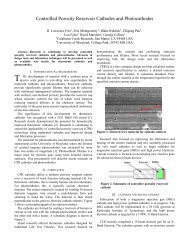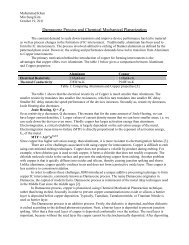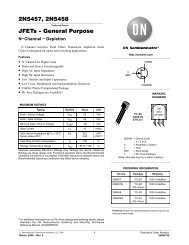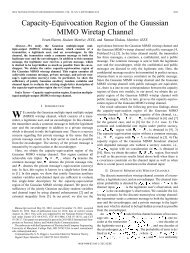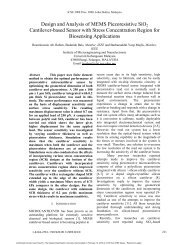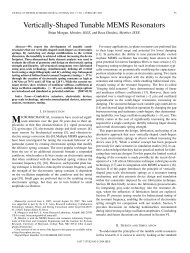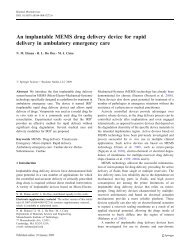A BioMEMS Review: MEMS Technology for Physiologically - ECE ...
A BioMEMS Review: MEMS Technology for Physiologically - ECE ...
A BioMEMS Review: MEMS Technology for Physiologically - ECE ...
You also want an ePaper? Increase the reach of your titles
YUMPU automatically turns print PDFs into web optimized ePapers that Google loves.
A. Microneedles<br />
The development of microneedles has taken advantage of<br />
the small feature size that can be achieved through microfabrication<br />
processes, mainly <strong>for</strong> noninvasive drug delivery<br />
applications. Several microfabricated microneedle schemes<br />
have been proposed, including microhypodermic needles,<br />
disposable arrays of microneedles <strong>for</strong> use with a syringe,<br />
and solid needles to increase skin permeability <strong>for</strong> use with<br />
a transdermal patch [91]–[93]. Microneedles can be used<br />
to deliver compounds to cells in culture or into localized<br />
regions of tissue inside the body, and can be fabricated from<br />
silicon, glass (silicon dioxide), and metal. Microneedles can<br />
deliver drugs transdermally without pain because they do<br />
not penetrate to skin layers that contain nerves, but they do<br />
penetrate far enough <strong>for</strong> the therapeutic compounds to enter<br />
systemic circulation [94].<br />
Microneedles produced an order of magnitude increase<br />
in cadaver skin permeability to model small molecules<br />
such as calcein [93]. The delivery of macromolecules<br />
such as oligodeoxynucleotides and ovalbumin has been<br />
demonstrated using stainless steel microprojection arrays<br />
(Macroflux, manufactured by Alza) [95], [96]. Comparable<br />
anti-ovalbumin antibody titers were obtained <strong>for</strong> dosages<br />
of 20 and 80 mg whether administered by microprojection<br />
array or the more traditional routes of intradermal, subcutaneous,<br />
or intramuscular injection.<br />
B. Injectable Micromodules<br />
Injectable micromodules are a new class of implants that<br />
are used to deliver electronic devices such as neuromuscular<br />
stimulators to the human body [97]. In this application, the<br />
ability to fabricate electronic devices with small feature sizes<br />
has allowed a high degree of functionality to be condensed<br />
into a very small device. Current micromodule systems are<br />
small enough to be implanted by percutaneous injection<br />
through large-gauge hypodermic needles, eliminating the<br />
need <strong>for</strong> surgical implantation. Moreover, each of the<br />
256 microstimulators in the system could be individually<br />
directed to produce electrical stimulation, offering a wide<br />
range of rehabilitative and therapeutic applications.<br />
The principle of injectable micromodules is basically the<br />
same as that of the commercially available radio frequency<br />
identification (RFID) devices. The RFID tag is a subminiature<br />
glass capsule containing a solenoidal coil and an integrated<br />
circuit, which <strong>for</strong>m a transcutaneous inductive link<br />
to power and communicate with the device [98]. Advances<br />
in monolithic electronic design and <strong>MEMS</strong> packaging technologies<br />
led to expansion of RFID technology to the medical<br />
field to create injectable micromodule systems. Current<br />
development is aimed at more complex functions such as<br />
bioelectric/goniometric/temperature sensing, and functional<br />
electrical stimulation [97], [99], [100].<br />
IV. BIOCOMPATIBILITY AND PRESERVATION OF TISSUE<br />
FUNCTION<br />
Thus far we have focused on how the application of<br />
microfabrication technology can improve the integration<br />
and function of implantable devices. Understanding the<br />
interaction between the implanted <strong>MEMS</strong> materials and<br />
the local cellular environment, and assessment of the immune<br />
response, are critical, however, <strong>for</strong> optimizing the<br />
per<strong>for</strong>mance of <strong>MEMS</strong> in vivo. In this section we review<br />
the current understanding of the biocompatibility of some<br />
common materials used in <strong>MEMS</strong> fabrication, examine<br />
strategies currently being used to improve the biocompatibility<br />
of <strong>MEMS</strong>, and briefly discuss some novel applications<br />
of microfabrication technology to actively control and direct<br />
cell attachment and growth.<br />
A. <strong>MEMS</strong> Material Biocompatibility<br />
Biocompatibility testing of implant materials is becoming<br />
increasingly complex, and <strong>MEMS</strong> devices have unique biocompatibility<br />
issues. The biocompatibility requirements vary<br />
considerably depending on the device function and design;<br />
biocompatibility is defined by The Williams Dictionary of<br />
Biomaterials as “the ability of a material to per<strong>for</strong>m with<br />
an appropriate host response in a specific application” [101].<br />
The per<strong>for</strong>mance of sensors (glucose, pH, etc.), <strong>for</strong> example,<br />
is limited by biofouling and isolation of the sensor surface.<br />
However, neural electrodes must remain in intimate contact<br />
with the neurons that they are stimulating or recording. The<br />
ISO 10 993 standards outline minimum tests of material characterization,<br />
toxicity, and biodegradation that may be augmented<br />
depending on actual device usage.<br />
Biocompatibility can be assessed using several types of<br />
tests. In vitro assays include leaching of material, corrosion<br />
testing, protein adsorption testing, and cell culturing on<br />
material samples. In vivo biocompatibility assays typically<br />
involve the implantation of material or a device at the<br />
eventual site of use (intramuscular, subcutaneous, etc.).<br />
In vitro assays are easier to per<strong>for</strong>m and provide more<br />
quantitative results, but in vivo assays are more relevant<br />
and can capture systemic effects. The local and systemic<br />
responses, such as fibrous capsule <strong>for</strong>mation, lymphocyte<br />
response, or accumulation of particulates in lymph nodes,<br />
are evaluated over days, weeks, or months. In vivo tests can<br />
also exhibit variation due to implant shape, surface texture,<br />
and size. Large implants, sharp edges, and implants that<br />
rub against tissue will induce a greater reaction in the host<br />
tissue. The variability of test design mirrors the variability<br />
of device function.<br />
The biocompatibility of <strong>MEMS</strong> materials was not addressed<br />
until recently because these materials were packaged<br />
or encapsulated away from direct contact with tissue and<br />
fluids; biocompatibility is a surface-mediated property, and<br />
the biocompatibility of a device depends only on those<br />
materials in contact with tissue. The biocompatibility of<br />
silicon and other <strong>MEMS</strong> materials has become much more<br />
important with the advent of implantable <strong>MEMS</strong> devices<br />
that interact directly with the body. The biocompatibility of<br />
some <strong>MEMS</strong> electrode materials has been studied, however,<br />
because of their use in other devices such as pacemaker<br />
electrodes and dental implants.<br />
Silicon substrates are the basis <strong>for</strong> most <strong>MEMS</strong> devices,<br />
and silicon compounds commonly enable device function.<br />
GRAYSON et al.: A BIO<strong>MEMS</strong> REVIEW: <strong>MEMS</strong> TECHNOLOGY FOR PHYSIOLOGICALLY INTEGRATED DEVICES 11<br />
Authorized licensed use limited to: University of Maryland College Park. Downloaded on February 8, 2009 at 16:17 from IEEE Xplore. Restrictions apply.



